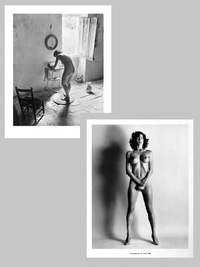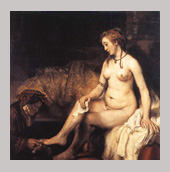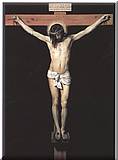


photography, writing, fine art... stuff ... other stuff ...
This page supersedes 'Reflection on Practice, January 03', but
I have kept that page on the site because I still like it as a simple opening statement of my
concerns. The January page is not exactly archived, as I have continued to tidy it up a bit and
add to the illustrative material (see, e.g. new background material to the Ronis image) but the
essential content is unchanged.
I want to develop here my consideration of the 'domestic' nude and the 'agonistic' nude.
During the last few months I have continued to keep Le Nu Provenšal, by Ronis, in mind. I
have taken it as a type of the domestic nude, both in guiding my thoughts at a theoretical
or historical level, and in providing me with a model for my own photographic work. In the
same way, I have kept Helmut Newton's Big Nudes series in mind, although Newton's work is
clearly less typical of the 'agonistic' nude than many more extreme images we could consider.
If you want to skip the general overview of the agonistic/domestic dichotomy, you can go straight to
a comparison of the Ronis and Newton images.
First, I want to consider the agonistic nude more directly. There are a number of key
points of reference for this, and I note them briefly here:
1. The Crucifixion. This is a dominant theme in the Western artistic tradition. Nor is it
an exclusively Western theme, being evidenced in Asian and African art, for instance,
where the growth of the Christian church has taken the iconography of the Christian religion
into non-Western cultures, often without any direct Western or European mediation. Christianity,
after all, has its roots in Semitic religion and Middle-Eastern culture.
The Crucifixion is where I
started to write about the agonistic nude, and that discussion still works as an
opener to the whole site, with a link directly from the warning message on the site's index page.
Two related strands of imagery can be linked to the Passion
of Christ. There are the images of Christian martyrs, male and female; and there
are images of torture and execution in a secular context. As Mitchell Merback in
particular has noted, depictions of secular execution and depictions of the
Passion of Christ have influenced each other directly and indirectly for much of
the mediaeval to modern period. ( Merback, M. The Thief, The Cross
and the Wheel
, Reaktion, London, 1999).
2. Images of War and the Heroes. Here I would include a wide range of
material, from the gods and heroes of the classical age, through the more historically-rooted
images and sculpture of early mediterranean culture. These traditions both feed the later European
tradition of history painting, and that in turn develops into the portrayal of personalities and
events from contemporary conflict, first in painting and sculpture, and through to photography.
3. Sadomasochistic imagery, including SM pornography. Given
the use of history painting as a justification for portrayal of the nude figure,
this category is as wide ranging as the two categories above. The flagellation
of Christ, for instance, is a centuries-old vehicle for what we would nowadays
consider to be SM porn, as are many martyrdoms. It is hard, for instance, to
find an example of the martyrdom of St Sebastian which does not have a prominent
homoerotic element. Complicating the issue here is the question of truthfulness
to historical events: it would be naive to rule out sexual gratification as a
significant motive among the torturers and killers either of Christian martyrs
or of prisoners or victims of secular conflicts. This is an issue discussed
usefully by Michael Gill, for example. (Gill, M. "Pathos or Pornography", in
Image of the Body
, New York, Doubleday, 1989)
The problem, then, is to hold all these themes together; whether we consider the Christian
Passion, the imagery of heroism and war, or SM, we are faced with, effectively, countless
specific images, in every conceivable medium. Even the Crucifixion appears in photographs,
from staged reenactments photographed in the 19th century ... to modern images such as Serrano's
Piss Christ, or Mapplethorpe's often surprisingly moving photographs of religious sculpture. The
iconography of the Passion reappears in Salgado's reportage photography from armed conflicts
in the developing world, and in the Benetton adverts directed by Olivero Toscani.
So the choice of Newton's photography as a Vorbild is arbitrary, and I am less concerned
to justify this theoretically than I am interested in understanding, retrospectively, how I
came to make that choice. I suspect it is largely because in Newton's work the erotic dimension,
rather than being discreetly hidden, is made explicit and emphatic. That is to say, Newton
doesn't try to hide the eroticism of power and of violence.
As with the agonistic nude, the domestic nude is wide-ranging. I began thinking about
it as the portayal of simple, everyday situations where nudity might naturally occur.
Washing, dressing, undressing, sleeping ... and, of course, the enjoyment of sex. All of
these are things which the vast majority of people do, and which they do, typically, in a
relatively private environment. They are activities typically carried out without coercion,
activities which most people take pleasure in. They are activities which are not staged, although
of course, all of them can be staged and all of them frequently are staged in the production of
both of pornography, and of marketing imagery for a wide range of fashion or lifestyle products.
Of all these activities, however, I have focused on the activity of washing. This is partly
an accident, I suspect; it simply happens that the Ronis image is an image of a woman washing.
It is also true, however, that images of women washing are a significant genre both in painting
and photography. They range from historical subjects such as Bathsheba or Pharaoh's daughter,
through to more modern and observationally based images such as Degas' pastels of women bathing.
Somehow, I sense that there is a connection between this primal activity and the concerns
I have for some kind of grace or healing. (See the discussion from January 03 of the Leonard
Cohen song, Light As The Breeze). I have found it particularly interesting, in that light,
to look at the writing of Wendy Lesser, and in particular her discussion of the Degas pastels.
Lesser also uses the word 'healing', but perhaps more characteristic words are 'closeness', and
'wholeness'; like Leonard Cohen, and like myself, however, her concerns are rooted in a sense of the
world as a difficult place, and human life as a difficult thing to live well.
I doubt that such untroubled wholeness is actually possible, or even
desirable. To be a divided self is not necessarily to lack anything, except insofar as we
all lack something, and are indeed defined by that lack.
Lesser, W. His Other Half:
men looking at women through art
, Harvard, Cambridge, 1991, p. 19.
There is a strange mirroring here, I find, given that I chose Newton partly because
he emphasises the erotic. Although the directly erotic nude has a place within my 'domestic'
category (when I try to be logical about it) ... I find myself constantly drawing a line to
exclude the deliberately erotic. This is not simply a matter of excluding
pornography, much of which I enjoy and find capable of great beauty and, in a sense, purity.
It is more a case of not wanting eroticism to overshadow something else which I sense in the
domestic nude. In so far as I am particularly interested in the female nude, I have to admit that,
in part, what I am about is an attempt to rediscover or rehabilitate the 'feminine'. And perhaps no
exercise could be more naff and futile.
So, no conclusions. A web site is not intrinsically a discursive thesis. It does not lend
itself to a neat progression from opening thesis to grounded conclusion or resolution. It
does not lay down a line of argument, but allows the viewer to move at will around a network
of linked materials. It is illustrative rather than didactic. So there is no conclusion here.
Ideally, my own work is the conclusion, at least in that it shows how the issues explored in the
historical and theoretical component of the site are producing outcomes. These outcomes
themselves, however, are intrinsically partial and provisional. As far as the writing is concerned,
I offer the occasional excursus, because I believe no more is possible.